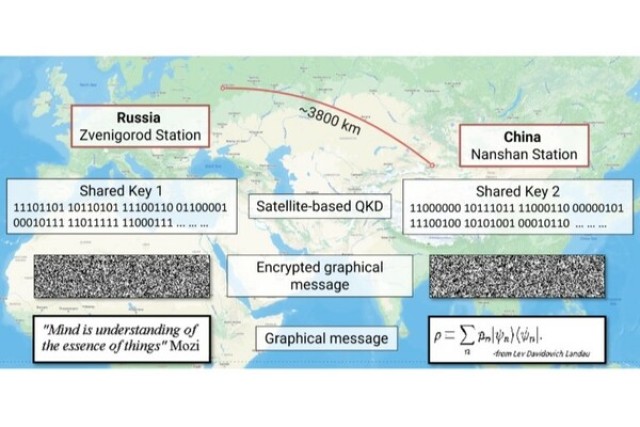For the first time in Russia, a team of scientists from MISIS University, the Russian Quantum Center (RCC) and the company KuSpace Technologies conducted a joint experiment on the transmission of messages protected by quantum cryptography between Russia and China, the university's press service reported. To transfer the encryption key over a distance of more than 3,500 km, a unique Mo-tzu quantum communication satellite developed by Chinese scientists was used. The ground station in Zvenigorod, created by Russian specialists, allowed the exchange of encoded images measuring 256 x 64 pixels with the ground station in Nanshan. The demonstration of satellite quantum communications technology on an international scale not only strengthens Russia's position in the quantum race, but also opens a practical path to the introduction of new data protection technologies.
In the world of digital communications, one of the obvious needs is to protect information so that attackers do not gain access to the transmitted data. This is important, for example, when we transfer our credit card details when shopping online. With the advent of a powerful quantum computer, these algorithms will be hacked. If a classical supercomputer would require millions of years of calculations to attack, then twenty hours is enough for a quantum one. If nothing is done, this will lead to the collapse of the information transmission system: the volume of transmitted information is growing by about 30% annually.
Traditional cryptography uses mathematical algorithms to protect information, while quantum cryptography is based on physics. If the information is encoded in single quanta, then it is impossible to read it unnoticeably. This makes it possible to transfer cryptographic keys. A serious limitation for such an infrastructure is the need to install intermediate trusted nodes due to the attenuation of the optical signal in the fiber through which photons are transmitted. Although such systems have already been created between Moscow and St. Petersburg. There is a 4,600 km long quantum network in China, which is used by banks and companies. To solve the problem of quantum communications between different continents, Chinese scientists have been working with the Mo-tzu satellite since 2016. For example, they have already shown quantum protection of the video conference between Beijing and Vienna. A team of Russian scientists from NUST MISIS, the Russian Quantum Center (RCC), CuSpace Technologies and their colleagues began working with the Mo-tzu satellite in 2019. Over the years, a number of experiments have been carried out, which made it possible to realize the quantum distribution of keys between two points at a distance of 3,800 km: between ground stations in Zvenigorod and Nanshan. The Russian side encoded the dictum of the philosopher Mo Tzu "Reason is an understanding of the essence of things", in response, Chinese colleagues sent the definition of the density operator of a mixed quantum state, first introduced by Lev Landau.
The receiving ground station in Zvenigorod — currently the only one in Russia – was created by Russian scientists on the basis of a telescope located on the territory of the Zvenigorod Observatory of the Institute of Astronomy of the Russian Academy of Sciences.
In their study, the scientists further explored possible vulnerabilities arising in quantum communications at a practical level. In theory, quantum cryptography allows you to achieve the durability of protection, which is guaranteed by the laws of physics. In practice, certain difficulties arise, in particular, devices for receiving single photons can work in different ways, which opens up opportunities for attack. In the conducted experiment, this loophole was eliminated. The research was supported by the strategic project of NUST MISIS "Quantum Internet" under the program of the Ministry of Education and Science of the Russian Federation "Priority 2030". The results obtained will allow us to get closer to the creation of high-speed quantum-protected satellite communication systems in Russia in the future.
Recall that in the summer of 2023, a prototype quantum satellite, the small spacecraft Impulse-1, developed by NUST MISIS and the company CuSpace Technologies, was launched from the Vostochny cosmodrome, which contains equipment that allows testing the transmission of information via a laser communication channel. A satellite with such functionality has been launched in Russia for the first time. Communication sessions are held normally. Large businesses have already begun to show interest in this area, and the development of quantum microsatellite technology is bringing the horizon of economic feasibility of introducing quantum technologies closer.
In Russia and in the world, industrial quantum cryptography systems are already being tested by large banks and telecommunications companies. For example, Rosatom and Rostelecom implemented a pilot project in this area. The quantum communications infrastructure is being built with the support of the Russian Railways Roadmap. There are also private companies in this market, for example, the KuRate company, founded with the support of the Russian Quantum Center, works in this area. According to various estimates, the global quantum cryptography market will grow by an average of almost 40% per year.

